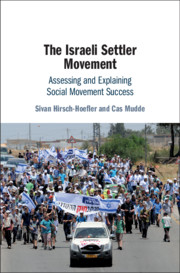Book contents
- The Israeli Settler Movement
- The Israeli Settler Movement
- Copyright page
- Dedication
- Contents
- Figures
- Preface
- Introduction
- 1 Theoretical Framework
- 2 History of the Settlements
- 3 History of the Settler Movement
- 4 Assessing the Settler Movement’s Success
- 5 The Action Repertoires of the Branches
- 6 A Case of Success
- 7 A Case of Failure
- 8 Conclusion
- Notes
- References
- Index
1 - Theoretical Framework
Published online by Cambridge University Press: 30 November 2020
- The Israeli Settler Movement
- The Israeli Settler Movement
- Copyright page
- Dedication
- Contents
- Figures
- Preface
- Introduction
- 1 Theoretical Framework
- 2 History of the Settlements
- 3 History of the Settler Movement
- 4 Assessing the Settler Movement’s Success
- 5 The Action Repertoires of the Branches
- 6 A Case of Success
- 7 A Case of Failure
- 8 Conclusion
- Notes
- References
- Index
Summary
A fundamental aspect of the study of social movements is the analysis of their success. However, before one can engage in such an assessment, we must first understand what success means in the context of social movements. For decades, scholars of collective action have paid only scant attention to the outcomes and political success of movement activities (Bosi et al. 2016; Giugni 2008), a fact that may be explained, at least in part, by the conceptual and methodological difficulties inherent in the task of explaining success (Amenta & Young 1999; Earl 2000).
- Type
- Chapter
- Information
- The Israeli Settler MovementAssessing and Explaining Social Movement Success, pp. 5 - 39Publisher: Cambridge University PressPrint publication year: 2020

